The holidays are a time for cheer, warmth, and the nostalgic Christmas tree smell that fills our homes. While artificial trees offer convenience and longevity, they lack the natural, inviting scent of a real evergreen. In this guide, we’ll share tips on infusing your tree with the essence of Christmas.
Understanding Different Christmas Tree Scents
The aroma of a Christmas tree can evoke joyful memories and enhance the holiday experience. Understanding these fragrances can help create a more memorable and immersive environment during the season.
What Does a Christmas Tree Smell Like?
The smell of a Christmas tree depends on its species. Fir, spruce, and pine trees are the most popular, and they produce terpenes that give them their distinctive scents. Fir and pine scents usually have rich camphor or menthol-like fragrances. Other coniferous trees feature terpenes that give off a variety of Christmas tree scents ranging from citrusy to warm and spicy to menthol-like or a combination of peppermint and citrus aromas.
The age, growing conditions, and post-harvest treatment of Christmas trees can also significantly influence their smells. Younger trees tend to have a more potent fragrance, and the environment in which they grow can also affect the intensity and quality of their aroma.
Types of Christmas Trees and Their Distinct Smells
Here are some of the most popular Christmas tree scents:
Balsam Fir – This fir is famous for its strong, refreshing pine scent, often associated with traditional Christmas smells.
Blue Spruce – Recognized for its silvery-blue foliage, the Blue Spruce emits a sharp, crisp scent.
Noble Fir – The Noble Fir provides a rich, woodsy aroma reminiscent of a forest.
Douglas Fir – This tree variety offers a somewhat citrusy aroma, blending sweetness with a hint of tartness.
Scotch Pine – It has a long-lasting, mild pine fragrance, ideal for those who prefer subtler scents.
Best Ways To Make an Artificial Christmas Tree Smell Real
Learning how to make your Christmas tree smell good is key to enhancing the holiday atmosphere. Here are some of the ways you can add that nostalgic Christmas tree scent to your home:
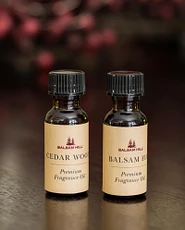
Essential Oils
Add a few drops of the oil onto cotton balls or a small piece of fabric, then place them discreetly around the tree. This method will help diffuse the scent without causing any harm or damage to the tree.
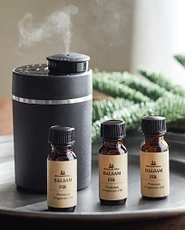
Diffusers
Diffusers spread essential oils into the air, filling the room with the desired scent. Place the machine near the tree, but not too close. Experiment with different positions to find the best one for the room.
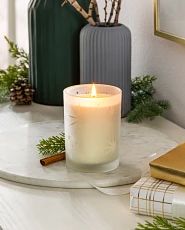
Scented Candles
Choose scented candles that mimic pine, fir, or spruce and place them a few feet away from the tree to avoid fire hazards. You can also try other scents like cinnamon, peppermint, or vanilla to create a warm and cozy atmosphere.
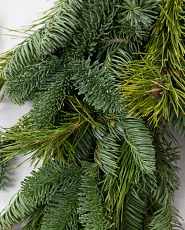
Real Branches
Natural branches are a great way to make an artificial Christmas tree smell real. Try fresh branches from pine, fir, or spruce trees and place them around the base of the tree or tuck them into the foliage for an added natural scent.
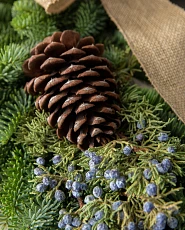
Scented Pinecones
If you’re picking them by yourself, clean them to remove sap and treat them for insects. But if natural pinecones aren’t available in your area, you can still achieve a pine scent for your artificial Christmas tree with store-bought natural pinecones infused with scented oils.
Frequently Asked Questions
Below are the answers to some of the most common questions about Christmas tree scents.
How Do I Make My Tree Smell Like Christmas?
Add scented ornaments or decorations to your tree, such as cinnamon sticks, dried orange slices, or pinecones. You can also hang some scented sachets or potpourri on the branches of your tree.
What Scent Smells Like Christmas?
Pine, cinnamon, peppermint, and nutmeg are commonly associated with Christmas. These scents are often used in candles, potpourri, and other holiday decorations to create a festive atmosphere.
What Scent Is The Real Christmas Tree?
The real Christmas tree scent is predominantly fresh pine, fir, or spruce. This natural aroma is crisp, woodsy, and slightly resinous, embodying the essence of winter forests and holiday spirit.
How Do You Recreate the Smell of a Christmas Tree?
If you’re wondering how to make your Christmas tree smell real, use essential oils such as pine, spruce, or fir. These oils can be diffused or applied to cotton balls and placed in tree branches. You can also use scented candles or create a DIY potpourri with pinecones and cinnamon to mimic the tree’s natural fragrance.
What Essential Oil Smells Like a Christmas Tree?
Essential oils that smell like a Christmas tree include pine, fir, and spruce oils. These oils capture the essence of a Christmas tree’s natural scent, providing a fresh, woodsy, and authentic holiday fragrance.
What’s the Best Christmas Tree Smell?
The best-smelling Christmas tree varies based on personal preference. Some popular options include the Balsam Fir, Fraser Fir, Douglas Fir, Pine, Spruce, and Cedar. Each type of tree has a unique scent that adds to the holiday atmosphere.
How Do I Make a Christmas Tree Smell Better?
There are several ways to make a Christmas tree smell better. If you have a real tree, add essential oils to the water in the tree stand or mist the tree with a mix of water, cinnamon, cloves, and other spices. For artificial Christmas trees, hang scented ornaments on the branches or insert some fresh pine or cedar branches into the foliage.
By incorporating these tips, your Balsam Hill artificial Christmas tree will look real and have the delightful, authentic scent of a fresh-cut tree. Click the button below to shop our collection of holiday and seasonal scents:
Learn More About Artificial Christmas Trees
Read these next to help you find the right Balsam Hill Christmas tree for your home:
